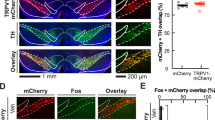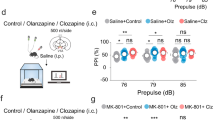Abstract
A projection of dopamine (DA) neurones has been identified which runs from the rat midbrain ventral tegmental area to the cerebral cortex1. Relative to other cortical areas, the prefrontal cortex is enriched in DA2,3, tyrosine hydroxylase3, DA uptake2,3, DA-sensitive adenylate cyclase2 and DA-responsive neurones4. Lesions of the prefrontal cortex or selective lesions of the prefrontal cortical DA innervation induce functional deficits, including detrimental effects on delayed response tasks, a difficulty in suppressing attention to irrelevant stimuli and a diminution in affective and social behaviour (for a review, see ref. 5). Recent studies have shown that this mesocortical DA system differs from other DA systems (such as the nigrostriatal and mesolimbic DA systems) in terms of drug responsiveness. For example, the acute administration of antipsychotic drugs (for example, haloperidol) greatly accelerates DA turnover in the nigrostriatal and mesolimbic DA systems through multiple sites of action, but only modestly accelerates mesocortical DA turnover. Following the chronic administration of moderate doses of antipsychotic drugs, tolerance to the effects of a haloperidol challenge dose is generally seen in the striatum and olfactory tubercle but not in the frontal cortex6–8. Similar results obtained in experiments involving primates have led to the suggestion that the frontal cortex may be the site of therapeutic action of the antipsychotic agents9,10. In light of the recent finding that rat mesocortical DA neurones lack terminal autoreceptors11, we have investigated the possible role of nerve terminal DA autoreceptors in mediating the varied responses seen in different brain regions following acute and chronic antipsychotic drug treatment. The results, reported here, suggest that both the relatively small activation of the mesocortical DA system in response to a haloperidol challenge, and the lack of tolerance to haloperidol following chronic treatment, may be related to the absence of nerve terminal autoreceptors.
This is a preview of subscription content, access via your institution
Access options
Subscribe to this journal
Receive 51 print issues and online access
$199.00 per year
only $3.90 per issue
Buy this article
- Purchase on Springer Link
- Instant access to full article PDF
Prices may be subject to local taxes which are calculated during checkout
Similar content being viewed by others
References
Thierry, A. M., Stinus, L., Blanc, G. & Glowinski, J. Brain Res. 50, 230–234 (1973).
Tassin, J. P. et al. Brain Res. 154, 241–251 (1978).
Emson, P. C. & Koob, G. F. Brain Res. 142, 249–267 (1978).
Bunney, B. S. & Aghajanian, G. K. Life Sci. 19, 1783–1792 (1976).
Fuster, J. M., The Prefrontal cortex: Anatomy, Physiology and Neuropsychology of the Frontal Lobe (Raven, New York, 1980).
Scatton, B. Eur. J. Pharmac. 46, 363–369 (1977).
Scatton, B., Garret, C. & Julou, L. Naunyn-Schmiedebergs Archs Pharmak. 289, 419–434 (1975).
Scatton, B., Glowinski, J. & Julou, L. Brain Res. 109, 184–189 (1976).
Bacopoulos, N. G., Bustos, G., Redmond, D. E., Baulu, J. & Roth, R. H. Brain Res., 157, 396–401 (1978).
Bacopoulos, N. G., Redmond, D. E., Baulu, J. & Roth, R. H. J. Pharmac. exp. Ther. 212, 1–5 (1980).
Bannon, M. J., Michaud, R. L. & Roth, R. H. Molec. Pharmac. 19, 270–275 (1981).
Bannon, M. J., Bunney, E. B., Zigun, J. R., Skirboll, L. R. & Roth, R. H. Naunyn-Schmiedebergs Archs Pharmak. 312, 161–165 (1980).
Konig, J. F. R. & Klippel, R. A. The Rat Brain: A Stereotaxis Atlas (Krieger, Huntingdon, 1970).
Michaud, R. L., Bannon, M. J. & Roth, R. H. J. Chromatogr. 225, 335–345 (1981).
Roth, R. H. Commun. Psychopharmac. 3, 429–445 (1979).
Kehr, W., Carlsson, A., Lindqvist, M., Magnusson, T. & Atack, C. J. Pharm. Pharmac. 24, 744–747 (1972).
Gianutsos, G., Thorburg, J. E. & Moore, K. E. Psychopharmacology 50, 225–229 (1976).
Nowycky, M. C. & Roth, R. H. Naunyn-Schmiedebergs Archs Pharmak. 300, 247–254 (1977).
Kehr, W., Carlsson, A. & Lindqvist, M. Naunyn-Schmiedebergs Archs Pharmak. 297, 111–117 (1977).
Roth, R. H., Walters, J. R. & Aghajanian, G. K. Frontiers in Catecholamine Research (eds Snyder, S. H. & Usdin, E.) 567–574 (Pergamon, New York, 1973).
Bannon, M. J., Bunney, E. B. & Roth, R. H. Brain Res. 218, 376–382 (1981).
Demerest, K. T. & Moore, K. E. J. neural Transmission 46, 263–277 (1979).
Author information
Authors and Affiliations
Rights and permissions
About this article
Cite this article
Bannon, M., Reinhard, J., Bunney, E. et al. Unique response to antipsychotic drugs is due to absence of terminal autoreceptors in mesocortical dopamine neurones. Nature 296, 444–446 (1982). https://doi.org/10.1038/296444a0
Received:
Accepted:
Issue Date:
DOI: https://doi.org/10.1038/296444a0
This article is cited by
-
Presynaptic regulation of extracellular dopamine levels in the medial prefrontal cortex and striatum during tyrosine depletion
Psychopharmacology (2013)
-
Modulation of high impulsivity and attentional performance in rats by selective direct and indirect dopaminergic and noradrenergic receptor agonists
Psychopharmacology (2012)
-
Altered spontaneous behavior and sensitivity to apomorphine in rats following pretreatment with S(+)-aporphines or fluphenazine
Psychopharmacology (1993)
-
Do autoreceptors mediate dopamine agonist — induced yawning and suppression of exploration? A critical review
Psychopharmacology (1992)
-
Dopaminergic neurotransmission in somatodendritic and terminal areas of the rat brain: susceptibility to modulation by D 1 and D2 receptors and to axotomy
Journal of Neural Transmission (1992)
Comments
By submitting a comment you agree to abide by our Terms and Community Guidelines. If you find something abusive or that does not comply with our terms or guidelines please flag it as inappropriate.



